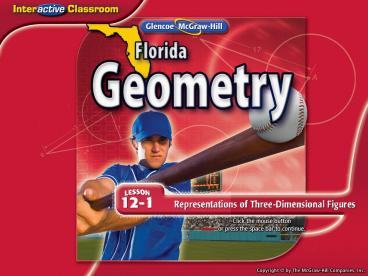Splash Screen - PowerPoint PPT Presentation
Title: Splash Screen
1
Splash Screen
2
Lesson Menu
Five-Minute Check (over Chapter
11) NGSSS Then/Now New Vocabulary Example 1 Use
Dimensions of a Solid to Sketch a Solid Example
2 Use an Orthographic Drawing to Sketch a
Solid Example 3 Real-World Example Identify
Cross Sections of Solids
3
5-Minute Check 1
Find the area of a rhombus with diagonals of 18
and 26.
A. 234 units2 B. 346 units2 C. 404 units2 D. 468
units2
- A
- B
- C
- D
4
5-Minute Check 2
Find the area of a trapezoid with bases of 14 and
30 and height of 5.
A. 188 units2 B. 142 units2 C. 110 units2 D. 104
units2
- A
- B
- C
- D
5
5-Minute Check 3
Find the area of a regular hexagon with side
length of 18.
A. 841.8 units2 B. 618.2 units2 C. 420.9
units2 D. 202.5 units2
- A
- B
- C
- D
6
5-Minute Check 4
Find the area of a square with apothem length of
9.
A. 648 units2 B. 527 units2 C. 437 units2 D. 324
units2
- A
- B
- C
- D
7
5-Minute Check 5
Find the area of a regular triangle with side
length of 15.
A. 82.3 units2 B. 97.4 units2 C. 106.5
units2 D. 112.7 units2
- A
- B
- C
- D
8
5-Minute Check 6
A. 21.3 ft2 B. 32 ft2 C. 72 ft2 D. 108 ft2
- A
- B
- C
- D
9
NGSSS
MA.912.G.7.3 Identify, sketch, find areas and/or
perimeters of cross sections of solid objects.
10
Then/Now
You identified parallel planes and intersecting
planes in three dimensional figures. (Lesson 31)
- Draw isometric views of three-dimensional figures.
- Investigate cross sections of three- dimensional
figures.
11
Vocabulary
- isometric view
- cross section
12
Example 1
Use Dimensions of a Solid to Sketch a Solid
Use isometric dot paper to sketch a triangular
prism 6 units high, with bases that are right
triangles with legs 6 units and 4 units long.
Step 1 Mark the corner of the solid, then
draw segments 6 units down, 6 units to the left,
and 4 units to the right.
13
Example 1
Use Dimensions of a Solid to Sketch a Solid
Step 2 Draw the triangle for the top of the solid.
14
Example 1
Use Dimensions of a Solid to Sketch a Solid
Step 3 Draw segments 6 units down from
each vertex for the vertical edges.
15
Example 1
Use Dimensions of a Solid to Sketch a Solid
Step 4 Connect the corresponding vertices.
Use dashed lines for the hidden edges. Shade
the top of the solid.
Answer
16
Example 1
Which diagram shows a rectangular prism 2 units
high, 5 units long, and 2 units wide?
- A
- B
- C
- D
17
Example 2
Use an Orthographic Drawing to Sketch a Solid
Use isometric dot paper and the orthographic
drawing to sketch a solid.
- The top view indicates one row of different
heights and one column in the front right.
18
Example 2
Use Dimensions of a Solid to Sketch a Solid
- The front view indicates that there are
four standing columns. The first column to the
left is 2 blocks high, the second column is 3
blocks high, the third column is 2 blocks high,
and the fourth column to the far right is 1
block high. The dark segments indicate breaks in
the surface.
- The right view indicates that the front right
column is only 1 block high. The dark segments
indicate a break in the surface.
19
Example 2
Use Dimensions of a Solid to Sketch a Solid
- The left view indicates that the back left
column is 2 blocks high. - Draw the figure so that the lowest columns are
in front and connect the dots on the isometric
dot paper to represent the edges of the solid.
Answer
20
Example 2
Which diagram is the correct corner view of the
figure given the following orthographic drawing?
- A
- B
- C
- D
21
Example 3
Identify Cross Sections of Solids
BAKERY A customer ordered a two-layer sheet
cake. Determine the shape of each cross section
of the cake below.
22
Example 3
Identify Cross Sections of Solids
Answer
If the cake is cut horizontally, the cross
section will be a rectangle.
If the cake is cut vertically, the cross section
will also be a rectangle.
23
Example 3
A solid cone is going to be sliced so that the
resulting flat portion can be dipped in paint and
used to make prints of different shapes. How
should the cone be sliced to make prints in the
shape of a triangle?
A. Cut the cone parallel to the base. B. Cut the
cone perpendicular to the base through the vertex
of the cone. C. Cut the cone perpendicular to the
base, but not through the vertex. D. Cut the cone
at an angle to the base.
- A
- B
- C
- D
24
End of the Lesson































